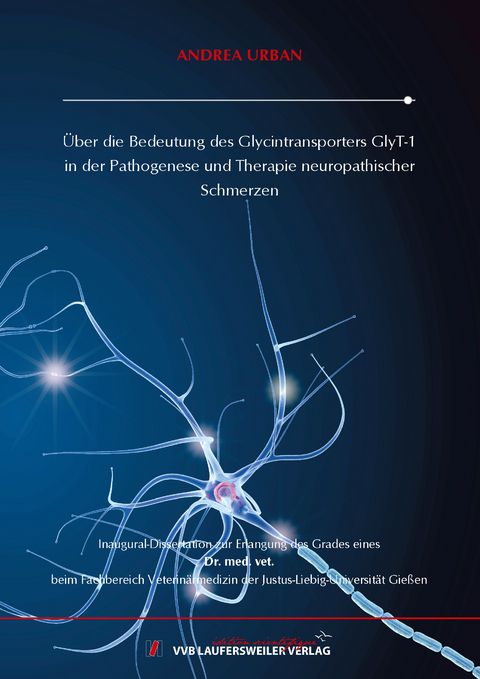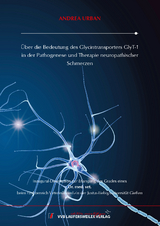Über die Bedeutung des Glycintransporters GlyT-1 in der Pathogenese und Therapie neuropathischer Schmerzen
Seiten
2021
VVB Laufersweiler Verlag
978-3-8359-6961-2 (ISBN)
VVB Laufersweiler Verlag
978-3-8359-6961-2 (ISBN)
- Keine Verlagsinformationen verfügbar
- Artikel merken
Jede Verletzung oder Erkrankung mit Beteiligung des Nervensystems birgt die Gefahr der Entwicklung chronischer neuropathischer Schmerzen. Die pharmakologische Therapie neuropathischer Schmerzen mit klassischen Analgetika erweist sich häufig als schwierig aufgrund von unerwünschten Wirkungen und/oder unzureichender Linderung der Symptome. Ein vielversprechender neuer Ansatz scheint, die bisher vorherrschende, weitestgehend symptomatische Therapie chronischer Schmerzen zu ersetzen durch stärker Mechanismus-orientierte Maßnahmen.
Zu den wesentlichen Pathomechanismen neuropathischer Schmerzen zählt die Imbalance zwischen hemmenden und erregenden Signalen zu Ungunsten der Inhibition. Die pharmakologische Interaktion mit inhibitorischer gabaerger und vor allem glycinerger Neurotransmission wird demnach als potenzielle zukünftige Therapieoption betrachtet.
Die vorliegende Arbeit verfolgte den Ansatz, dass die verstärkte Hemmung neuronaler Reizweiterleitung durch Inhibition des Glycintransporters-1 mittels ALX-5407 mechanische Allodynie und thermale Hyperalgesie im CCI-Modell für neuropathische Schmerzen verringert. Hierzu wurden männliche Wistar Ratten operiert und mittels Plantartest und Aesthesiometer auf Verhaltensänderungen untersucht. Insbesondere eine länger andauernde subkutane Applikation sollte zeigen, ob sich ALX-5407 eignet, die Symptome neuropathischer Schmerzen positiv zu beeinflussen. Hierzu wurde den neuropathischen Versuchstieren eine Osmosepumpe mit unterschiedlichen Konzentrationen des Inhibitors implantiert bzw. einer Kontrollgruppe lediglich Vehikellösung. Um die Wirkungsweise des Glycintransporter1-Inhibitors zu untersuchen, wurde auf Proteinebene der Einfluss der chronischen Inhibitor Applikation auf die Expression von GlyT-1 und NMDA-R im zentralen Nervensystem untersucht. Der Nachweis erfolgte auf Rückenmarksgewebe mittels Western blot-Analyse und Immunfärbung. Zur Kontrolle wurde einer Gruppe unbehandelter Ratten ebenfalls Rückenmarksgewebe entnommen und untersucht.
Im CCI-Modell konnten bei Ratten die Symptome thermale Hyperalgesie und mechanische Allodynie neuropathischer Schmerzen über die Dauer von 14 Tagen signifikant vermindert werden. Zusätzlich konnte in der vorliegenden Arbeit gezeigt werden, dass die kontinuierliche subkutane Applikation von ALX- 5407 ohne sichtbare Nebenwirkungen, bei erhaltener erwünschter, schmerzlindernder Wirkung, eine praktikable Methode der Verabreichung darstellt. Eine Veränderung im Expressionsmuster von Gycintransporter-1 und NMDA-Rezeptor durch Induktion von neuropathischen Schmerzen ließ sich in der vorliegenden Arbeit nicht nachweisen. Die Untersuchung von lumbalem Rückenmark neuropathischer Versuchstiere, die mit einer Dosis von 200µg/kg Körpergewicht ALX-5407 behandelt worden sind, ergab jedoch eine signifikante Verringerung von NMDA-R. Diese Ergebnisse zeigen, dass eine systemische Langzeit-Applikation eines spezifischen Glycintransporter-1-Inhibitors die Symptome experimenteller chronischer neuropathischer Schmerzen ohne wesentliche Nebenwirkungen signifikant lindern kann. Darüber hinaus scheint die chronische Gabe des Inhibitors durch eine Verminderung der NMDA-R Expression im Rückenmark auch auf maladaptive neuroplastische Prozesse im somatosensorischen Nervensystem Einfluss zu nehmen. Dies könnte ein Hinweis sein, dass die Hemmung von Glycintransporter-1 im Kontext neuropathischer Schmerzen nicht nur rein symptomatische, sondern auch kausal therapeutisch wirksam ist. Weitergehende experimentelle Untersuchungen sind erforderlich, um dies zu verifizieren. Darüber hinaus müssen klinische Untersuchungen zeigen, ob das Konzept der Hemmung von Glycintransportern auch bei humanen chronischen Schmerzen wirksam ist. Any injury or illness involving the nervous system increases the risk of chronic neuropathic pain developing.
The pharmacological therapy of neuropathic pain with common analgesia often proves difficult due to adverse effects and / or insufficient symptom relief.
A promising new approach seems to be to replace the predominant symptomatic therapy of chronic pain with more mechanism-oriented measures.
One of the main pathomechanisms of neuropathic pain is the imbalance between inhibitory and excitatory signals to the disadvantage of inhibition.
The pharmacological interaction with inhibitory gABAergic and especially glycinergic neurotransmission is therefore considered a potential treatment option in the future.
The present work’s hypothesis was that the enhanced inhibition of neuronal stimulus conduction by inhibition of glycine transporter-1 via ALX-5407 reduces mechanical allodynia and thermal hyperalgesia in the CCI model for neuropathic pain. For this purpose, male Wistar rats were operated on and examined for changes in behavior using the Plantar Test and Aesthesiometer.
Especially a prolonged subcutaneous application was meant to assess whether ALX-5407 positively influences the symptoms of neuropathic pain. For this purpose, an osmotic infusion pump with different concentrations of the inhibitor was implanted in the neuropathic test animals, and the control group was given a vehicle solution. In order to investigate the Glycine Transporter1 inhibitor’s mode of action, the effect of chronic application of the inhibitor on the expression of GlyT-1 and NMDA-R in the central nervous system was examined at protein level. Detection was carried out on spinal cord tissue using Western blot analysis and immunostaining. As a control, spinal cord tissue was also taken from a group of untreated rats and examined.
In the CCI model, the symptoms of thermal hyperalgesia and mechanical allodynia of neuropathic pain were significantly reduced over a period of 14 days.
The present work also shows that the continuous subcutaneous application of ALX-5407 maintains the desired analgesic effect without visible side effects and is a practical method of administration.
No change in the expression pattern of Gycintransporter-1 and NMDA receptor by induction of neuropathic pain could be demonstrated in the present work.
However, examining the lumbar spinal cord of neuropathic animals treated with a dose of 200µg / kg body weight ALX-5407 showed a significant reduction in NMDA-R.
These results show that long-term systemic application of a specific glycine transporter 1 inhibitor can significantly alleviate symptoms of experimental chronic neuropathic pain without major adverse effects. In addition, the chronic administration of the inhibitor seems to influence maladaptive neuroplastic processes in the somatosensory nervous system by reducing the NMDA-R expression in the spinal cord. This might indicate that the inhibition of glycine transporter-1 in the context of neuropathic pain is not only a purely symptomatic treatment, but also treats the cause. Further experimental investigations are required to verify this. Ultimately clinical studies will have to show whether the concept of inhibiting glycine transporters is also effective in chronic human pain.
Zu den wesentlichen Pathomechanismen neuropathischer Schmerzen zählt die Imbalance zwischen hemmenden und erregenden Signalen zu Ungunsten der Inhibition. Die pharmakologische Interaktion mit inhibitorischer gabaerger und vor allem glycinerger Neurotransmission wird demnach als potenzielle zukünftige Therapieoption betrachtet.
Die vorliegende Arbeit verfolgte den Ansatz, dass die verstärkte Hemmung neuronaler Reizweiterleitung durch Inhibition des Glycintransporters-1 mittels ALX-5407 mechanische Allodynie und thermale Hyperalgesie im CCI-Modell für neuropathische Schmerzen verringert. Hierzu wurden männliche Wistar Ratten operiert und mittels Plantartest und Aesthesiometer auf Verhaltensänderungen untersucht. Insbesondere eine länger andauernde subkutane Applikation sollte zeigen, ob sich ALX-5407 eignet, die Symptome neuropathischer Schmerzen positiv zu beeinflussen. Hierzu wurde den neuropathischen Versuchstieren eine Osmosepumpe mit unterschiedlichen Konzentrationen des Inhibitors implantiert bzw. einer Kontrollgruppe lediglich Vehikellösung. Um die Wirkungsweise des Glycintransporter1-Inhibitors zu untersuchen, wurde auf Proteinebene der Einfluss der chronischen Inhibitor Applikation auf die Expression von GlyT-1 und NMDA-R im zentralen Nervensystem untersucht. Der Nachweis erfolgte auf Rückenmarksgewebe mittels Western blot-Analyse und Immunfärbung. Zur Kontrolle wurde einer Gruppe unbehandelter Ratten ebenfalls Rückenmarksgewebe entnommen und untersucht.
Im CCI-Modell konnten bei Ratten die Symptome thermale Hyperalgesie und mechanische Allodynie neuropathischer Schmerzen über die Dauer von 14 Tagen signifikant vermindert werden. Zusätzlich konnte in der vorliegenden Arbeit gezeigt werden, dass die kontinuierliche subkutane Applikation von ALX- 5407 ohne sichtbare Nebenwirkungen, bei erhaltener erwünschter, schmerzlindernder Wirkung, eine praktikable Methode der Verabreichung darstellt. Eine Veränderung im Expressionsmuster von Gycintransporter-1 und NMDA-Rezeptor durch Induktion von neuropathischen Schmerzen ließ sich in der vorliegenden Arbeit nicht nachweisen. Die Untersuchung von lumbalem Rückenmark neuropathischer Versuchstiere, die mit einer Dosis von 200µg/kg Körpergewicht ALX-5407 behandelt worden sind, ergab jedoch eine signifikante Verringerung von NMDA-R. Diese Ergebnisse zeigen, dass eine systemische Langzeit-Applikation eines spezifischen Glycintransporter-1-Inhibitors die Symptome experimenteller chronischer neuropathischer Schmerzen ohne wesentliche Nebenwirkungen signifikant lindern kann. Darüber hinaus scheint die chronische Gabe des Inhibitors durch eine Verminderung der NMDA-R Expression im Rückenmark auch auf maladaptive neuroplastische Prozesse im somatosensorischen Nervensystem Einfluss zu nehmen. Dies könnte ein Hinweis sein, dass die Hemmung von Glycintransporter-1 im Kontext neuropathischer Schmerzen nicht nur rein symptomatische, sondern auch kausal therapeutisch wirksam ist. Weitergehende experimentelle Untersuchungen sind erforderlich, um dies zu verifizieren. Darüber hinaus müssen klinische Untersuchungen zeigen, ob das Konzept der Hemmung von Glycintransportern auch bei humanen chronischen Schmerzen wirksam ist. Any injury or illness involving the nervous system increases the risk of chronic neuropathic pain developing.
The pharmacological therapy of neuropathic pain with common analgesia often proves difficult due to adverse effects and / or insufficient symptom relief.
A promising new approach seems to be to replace the predominant symptomatic therapy of chronic pain with more mechanism-oriented measures.
One of the main pathomechanisms of neuropathic pain is the imbalance between inhibitory and excitatory signals to the disadvantage of inhibition.
The pharmacological interaction with inhibitory gABAergic and especially glycinergic neurotransmission is therefore considered a potential treatment option in the future.
The present work’s hypothesis was that the enhanced inhibition of neuronal stimulus conduction by inhibition of glycine transporter-1 via ALX-5407 reduces mechanical allodynia and thermal hyperalgesia in the CCI model for neuropathic pain. For this purpose, male Wistar rats were operated on and examined for changes in behavior using the Plantar Test and Aesthesiometer.
Especially a prolonged subcutaneous application was meant to assess whether ALX-5407 positively influences the symptoms of neuropathic pain. For this purpose, an osmotic infusion pump with different concentrations of the inhibitor was implanted in the neuropathic test animals, and the control group was given a vehicle solution. In order to investigate the Glycine Transporter1 inhibitor’s mode of action, the effect of chronic application of the inhibitor on the expression of GlyT-1 and NMDA-R in the central nervous system was examined at protein level. Detection was carried out on spinal cord tissue using Western blot analysis and immunostaining. As a control, spinal cord tissue was also taken from a group of untreated rats and examined.
In the CCI model, the symptoms of thermal hyperalgesia and mechanical allodynia of neuropathic pain were significantly reduced over a period of 14 days.
The present work also shows that the continuous subcutaneous application of ALX-5407 maintains the desired analgesic effect without visible side effects and is a practical method of administration.
No change in the expression pattern of Gycintransporter-1 and NMDA receptor by induction of neuropathic pain could be demonstrated in the present work.
However, examining the lumbar spinal cord of neuropathic animals treated with a dose of 200µg / kg body weight ALX-5407 showed a significant reduction in NMDA-R.
These results show that long-term systemic application of a specific glycine transporter 1 inhibitor can significantly alleviate symptoms of experimental chronic neuropathic pain without major adverse effects. In addition, the chronic administration of the inhibitor seems to influence maladaptive neuroplastic processes in the somatosensory nervous system by reducing the NMDA-R expression in the spinal cord. This might indicate that the inhibition of glycine transporter-1 in the context of neuropathic pain is not only a purely symptomatic treatment, but also treats the cause. Further experimental investigations are required to verify this. Ultimately clinical studies will have to show whether the concept of inhibiting glycine transporters is also effective in chronic human pain.
| Erscheinungsdatum | 28.06.2021 |
|---|---|
| Reihe/Serie | Edition Scientifique |
| Verlagsort | Gießen |
| Sprache | deutsch |
| Maße | 148 x 210 mm |
| Gewicht | 190 g |
| Themenwelt | Medizin / Pharmazie |
| Veterinärmedizin | |
| Schlagworte | Neurologie • Promotion • Schmerztherapie |
| ISBN-10 | 3-8359-6961-7 / 3835969617 |
| ISBN-13 | 978-3-8359-6961-2 / 9783835969612 |
| Zustand | Neuware |
| Informationen gemäß Produktsicherheitsverordnung (GPSR) | |
| Haben Sie eine Frage zum Produkt? |
Mehr entdecken
aus dem Bereich
aus dem Bereich
Buch | Softcover (2023)
Standard Systeme (Verlag)
CHF 31,95




